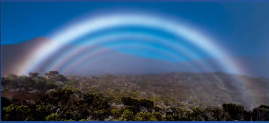Corona Iridescence, Arago's bright Spot
Corona Iridescence: A Phenomenon of Colorful Clouds
Corona iridescence, also known as Arago's bright spot, is a fascinating atmospheric optics phenomenon that occurs when light interacts with small water droplets in clouds. This mesmerizing display of colors and patterns can be observed under specific conditions, adding a touch of magic to the sky. In this article, we will delve deeper into the science behind corona iridescence and explore the various factors that contribute to its occurrence.
The Enchanting Display
Len Lamberg and Mary Beth Danielson were fortunate enough to witness corona iridescence in Waukesha, Wisconsin, USA. On a relatively clear and sunny day, they noticed unusual white clouds moving swiftly across the sky. These clouds exhibited a peculiar interior structure, appearing as if they were boiling up and rolling within themselves. The iridescence was most prominent near the fringes and became more visible when the clouds were closer to the sun.
Unraveling the Science
The vibrant colors and Mandelbrot-like corona observed during corona iridescence are a result of diffraction. When sunlight passes through small water droplets in the clouds, it interacts with them individually, causing the waves to diffract and scatter in all directions. This diffraction creates a series of outward spherical waves that overlap and interfere with each other, resulting in the stunning display of colors.
If the sky were covered by a thin layer of clouds with droplets of the same size, we would witness a colorful ringed glory opposite the sun. Facing away from the sun, there would be an almost white fogbow with additional colorful supernumerary fringes. Around the sun, more color rings and a central bright disk, known as a corona, would form. It's important to note that these are all different components of the same diffraction and interference process, showcasing the complexity and beauty of nature.
The Role of Clouds
Clouds play a significant role in the occurrence of corona iridescence. The clouds responsible for this phenomenon are known as altocumulus lacunosus, identified by cloud expert Ian Loxley of the Cloud Appreciation Society. These clouds form when a layer of rising warm air and a layer of cold air come into contact with each other. However, altocumulus lacunosus clouds are typically short-lived and dissipate rapidly, making the observation of corona iridescence a rare and fleeting experience.
Debating Light Diffraction
In the 19th century, a famous debate took place in the French Academy of Sciences regarding the diffraction of light around solid objects. The debate centered around Sir Isaac Newton's particle theory of light, which proposed that sharp shadows should be observed, and Christiaan Huygens' wave theory, which suggested otherwise. Despite Huygens' theory being more successful, Newton's reputation hindered its acceptance.
The turning point came when Academicians Augustin-Jean Fresnel and Siméon Denis Poisson further developed wave theory and predicted the existence of a bright spot in the center of a shadow. This prediction was met with skepticism and ridicule until Dominique Arago conducted an experiment to prove its validity. Arago's experiment, which did not involve lasers like modern reproductions, successfully demonstrated the presence of the bright spot at the center of a shadow. This discovery solidified the dominance of wave theory in explaining diffraction phenomena.
Capturing the Phenomenon
Observing and capturing corona iridescence can be quite challenging, both historically and in modern times. Even with the aid of lasers, capturing the faint bright spot at the center of a shadow requires precision and technical expertise. Michiel de Boer managed to reproduce Arago's experiment by imaging the shadow side of a laser-illuminated ball bearing, successfully capturing the elusive bright spot.
In conclusion, corona iridescence, or Arago's bright spot, is a captivating atmospheric optics phenomenon that occurs when light interacts with small water droplets in clouds. Through diffraction and interference, this interaction creates a mesmerizing display of colors and patterns. While observing corona iridescence is a rare occurrence due to the specific conditions required, it serves as a reminder of the beauty and complexity of the natural world.


Len Lamberg
Len Lamberg and Mary Beth Danielson saw this at Waukesha, Wisconsin, USA.
Len says: "The clouds were unusual. It was a relatively clear, sunny day with several
strange white clouds moving fairly quickly across the sky. Their interior structure moved quickly, as though it was boiling up and rolling about itself inside.
The iridescence was near the fringe and mostly visible when the cloud was close to the sun."

Another part of the same clouds and an exercise for the pareidolically inclined.
Diffraction
Diffraction produced the iridescent colours and the Mandelbrot-like corona.
Small water droplets in clouds individually interact with plane waves from the
sun. The droplets diffract and scatter the waves as a series of outward spherical waves.

They overlap and interfere.
If the sky was covered by a thin cloud layer of same size droplets we would see a colourful ringed glory opposite the sun.
Still facing away from the sun would be an almost white fogbow with more colourful supernumerary fringes.

Then, around the sun would be more colour rings and a central bright disk, a corona.
These are all one - Names for just parts of the same diffraction and interference process.
Change to lumpy clouds with differing droplet sizes and the ideal corona flakes away into shimmering iridescence. Think of cloud iridescence as a shattered corona
Clouds
The clouds have bubble-like voids, as though moths have been at them.
Cloud expert lan Loxley of the Cloud Appreciation Society identified them as altocumulus lacunosus.
He says "My best explanation is that the clouds form when a layer of rising warm air and a layer of cold air come into contact with one another. These clouds are usually very short-lived dissipating quite rapidly."

Impossible light inside shadows?
Diffraction of light around solid objects like water drops or ball bearings is against our macro intuition. We expect sharp black shadows.
So went a famous debate in the 19th Century French Academy of Sciences. In essence it was
between Newton's particle theory of light (sharp shadows) and Christiaan Huygens' wave theory.
Huygens' theory was already the more successful but Newton's reputation held back its acceptance. The crux came when wave theory was developed further by Academicians Fresnel and Poisson. They predicted a bright spot in the very centre of a shadow. France was
rocked - Absurde! Ridicule!
Non! - Dominique Arago searched and found it soon afterwards. Waves rule.
The spot is faint and Arago's experiment without lasers was hard indeed. Even with lasers it is difficult. At right is a modern repeat of the famous experiment. Michiel de Boer imaged the shadow side of a laser illuminated ball bearing. The bright spot is there at shadow centre!
Note: this article has been automatically converted from the old site and may not appear as intended. You can find the original article here.
Reference Atmospheric Optics
If you use any of the definitions, information, or data presented on Atmospheric Optics, please copy the link or reference below to properly credit us as the reference source. Thank you!
-
<a href="https://atoptics.co.uk/blog/corona-iridescence-aragos-bright-spot/">Corona Iridescence, Arago's bright Spot</a>
-
"Corona Iridescence, Arago's bright Spot". Atmospheric Optics. Accessed on November 26, 2024. https://atoptics.co.uk/blog/corona-iridescence-aragos-bright-spot/.
-
"Corona Iridescence, Arago's bright Spot". Atmospheric Optics, https://atoptics.co.uk/blog/corona-iridescence-aragos-bright-spot/. Accessed 26 November, 2024
-
Corona Iridescence, Arago's bright Spot. Atmospheric Optics. Retrieved from https://atoptics.co.uk/blog/corona-iridescence-aragos-bright-spot/.